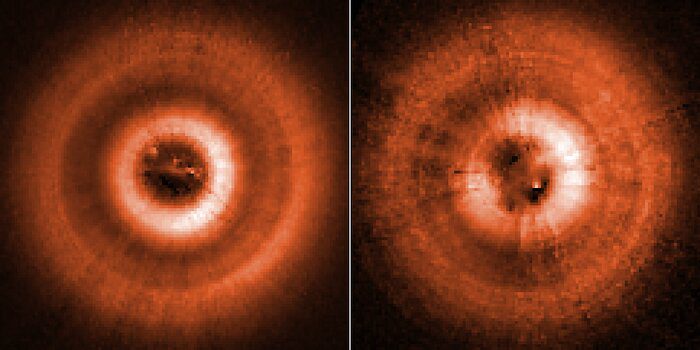It seems that Hubble not only tracks light near and far, but it can also track shadows. Planets forming in the system of the star TW Hydrae are shifting the material in the protoplanetary disk where they are formed. These rings are becoming misaligned with the much larger outer disk – and as the planets move, so do the rings, and they have been casting shadows.
One such shadow was first reported in 2017, and a new one is now being reported. The new one appears to be emerging from the first, suggesting that these forming planets and their rings were caught at a moment where they were matching each other in speed. Now one has overtaken the other, revealing that there are at least two forming planets in this system.
The disk in 2016 (left) has a brighter area in the bottom right and darker in the top left, suggesting a shadow. In the 2021 observations, the shadows appear to be two at the bottom and top left. Image Credit: NASA, ESA, J. Debes STScI
“We found out that the shadow had done something completely different,” John Debes, who is the principal investigator and lead author of the study, said in a statement. “When I first looked at the data, I thought something had gone wrong with the observation because it wasn’t what I was expecting. I was flummoxed at first, and all my collaborators were like: what is going on? We really had to scratch our heads and it took us a while to actually figure out an explanation.”
TW Hydrae is less than 10 million years old, one of the dozens of newly born systems that astronomers have been studying over the last decade or so. There is still so much to learn about these nascent systems, and observations such as these are contributing enormously to our understanding.
“We’ve never really seen this before on a protoplanetary disk. It makes the system much more complex than we originally thought,” Debes said.
The two inner disks have an inclination of five to seven degrees when compared to the outer larger disk. This is consistent with some planets in the solar system – Mercury compared to Earth, for example. The team also reports that, in the larger disk, there is a gap forming twice as far as Pluto is from the Sun. Maybe that is a third planet.
Future observations from JWST might provide further insights. Astronomers think that an observatory like ESA’s Gaia could help by measuring the minute variation in the star due to the gravitational tugging from the planet. That would take years though, as the period of these forming worlds is extremely long.
The research describing the last observations of TW Hydrae is published in The Astrophysical Journal.
Source Link: Shadows Of Forming Planets Tracked By Hubble
